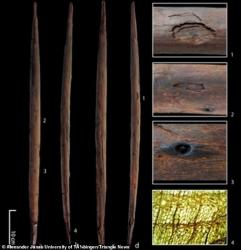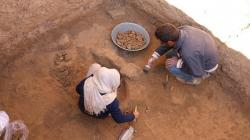ONLINE COURSES / COURS A DISTANCE
WINTER TERM : APRIL 2020
REGISTER NOW
EGYPTE – Saqqara - Egypt’s Ministry of Tourism and Antiquities has revealed a new archaeological discovery. The discovery was at the sacred animal necropolis in Saqqara where there have been two other archaeological discoveries during the past two years. The most important of these were the gorgeously decorated tomb of Wahti and a cachette of sacred birds and animals from which many animal mummies — some extremely rare — were brought to light. According to the Ministry of Antiquities, the latest discovery was at the bottom of a 11-meter-deep shaft. Five sealed stone coffins/sarcophagi were found, and four niches in a room containing wooden coffins and late-era human burials. A massive anthropoid wooden coffin with hieroglyphs written in yellow pigment was discovered in one niche. “We found several other artifacts around the coffin,” the ministry said. “They included 365 faience Ushabti figurines, some of which bear hieroglyphs texts; a small wooden obelisk about 40 cm tall, all four of its sides bearing painted scenes depicting the deities Isis and Nephthys, and the deity Horus; wooden statues of the god Ptah-Sokar-Osiris; and three pottery canopic jars in which the viscera removed during mummification was kept, in addition to many other artifacts.” Rihan said that the find dated to the late Pharaonic kingdom following the third transitional era and prior to the Ptolemaic Era, dating back to 332 B.C. Egyptian archaeologists do not all agree on the beginning of the late era. However, they do agree that it was around the late 25th Dynasty and before or during the 26th Dynasty.
https://www.arabnews.com/node/1662341/middle-east
ROYAUME UNI –  Tulloch - A six-foot-tall monolith called the Tulloch Stone offers new evidence of the beliefs of the elusive Picts of ancient Britain, who resisted the Romans and later formed powerful independent Scottish kingdoms. Discovered by construction workers during a road project in central Scotland, the stone features a carving thought to date to the fifth or sixth century A.D. of a possibly unclothed man carrying a spear with a doorknob-shaped end. Similar figures, each holding an identical spear, are carved on two other Pictish stones that were found in cemeteries in Scotland dating to roughly the same period. Archaeologist Gordon Noble of the University of Aberdeen says that, rather than representing deceased individuals, all three carvings probably depict a pagan warrior god. “By the post-Roman period, this was very much a warrior-oriented society,” Noble says. “These images seem to represent a distinctive regional manifestation of a warrior ideology.”
Tulloch - A six-foot-tall monolith called the Tulloch Stone offers new evidence of the beliefs of the elusive Picts of ancient Britain, who resisted the Romans and later formed powerful independent Scottish kingdoms. Discovered by construction workers during a road project in central Scotland, the stone features a carving thought to date to the fifth or sixth century A.D. of a possibly unclothed man carrying a spear with a doorknob-shaped end. Similar figures, each holding an identical spear, are carved on two other Pictish stones that were found in cemeteries in Scotland dating to roughly the same period. Archaeologist Gordon Noble of the University of Aberdeen says that, rather than representing deceased individuals, all three carvings probably depict a pagan warrior god. “By the post-Roman period, this was very much a warrior-oriented society,” Noble says. “These images seem to represent a distinctive regional manifestation of a warrior ideology.”
https://www.archaeology.org/issues/380-2005/digs/8610-digs-scotland-pictish-stone
MEDITERRANEE –  Levant - Archaeologists have found shipwrecks in the Mediterranean filled with hundreds of artefacts including Chinese porcelain, jugs, coffee pots, peppercorns and illicit tobacco pipes. A British-led expedition found a cluster of 12 ships on the sea bed, 1.2 miles below the surface of the Levantine Sea, using sophisticated robots. The ships were recovered in ancient 'shipping lanes' that served spice and silk trades of the Greek, Roman and Ottoman empires, from 300 BC onwards. The ancient ships – including the biggest ever found in the Med – were unearthed in a muddy part of the eastern seabed between Cyprus and Lebanon, where remnants are often hard to find.
Levant - Archaeologists have found shipwrecks in the Mediterranean filled with hundreds of artefacts including Chinese porcelain, jugs, coffee pots, peppercorns and illicit tobacco pipes. A British-led expedition found a cluster of 12 ships on the sea bed, 1.2 miles below the surface of the Levantine Sea, using sophisticated robots. The ships were recovered in ancient 'shipping lanes' that served spice and silk trades of the Greek, Roman and Ottoman empires, from 300 BC onwards. The ancient ships – including the biggest ever found in the Med – were unearthed in a muddy part of the eastern seabed between Cyprus and Lebanon, where remnants are often hard to find.
https://www.dailymail.co.uk/sciencetech/article-8240287/12-shipwrecks-uncovered-east-Med-dating-300-BC.html
ALLEMAGNE –  Schöningen - A 300,000-year-old hunting stick capable of killing large animals has been uncovered in Germany. The wooden throwing stick, used by the extinct human subspecies Homo heidelbergensis, was capable of killing waterbirds and horses during the Ice Age. Experiments show the 25-inch-long throwing stick, carved from spruce wood, could reach maximum speeds of 98 feet (30 meters) per second. Researchers have said the weapon was thrown like a boomerang, with one sharp side and one flat side, and spun powerfully around a centre of gravity. But when in flight, the weapon, also referred to as 'rabbit stick' or 'killing stick', did not return to the thrower. 'They are effective weapons over different distances, among other things when hunting water birds,' said Dr Jordi Serangeli, professor at the Institute for Prehistory. 'Bones of swans and ducks are well documented from the find layer. 'In addition, it is likely that larger mammals, such as horses that were often hunted on the shores of Lake Schöningen, were startled and driven in a certain direction with the throwing stick.' Researchers uncovered the weapon during an archaeological excavation at the Schöningen mine in Lower Saxony, northern Germany. The stick, carved from spruce wood, is around 25 inches (64.5cm) long, just over 1 inch (2.9cm) in diameter and weighs 264 grams.
Schöningen - A 300,000-year-old hunting stick capable of killing large animals has been uncovered in Germany. The wooden throwing stick, used by the extinct human subspecies Homo heidelbergensis, was capable of killing waterbirds and horses during the Ice Age. Experiments show the 25-inch-long throwing stick, carved from spruce wood, could reach maximum speeds of 98 feet (30 meters) per second. Researchers have said the weapon was thrown like a boomerang, with one sharp side and one flat side, and spun powerfully around a centre of gravity. But when in flight, the weapon, also referred to as 'rabbit stick' or 'killing stick', did not return to the thrower. 'They are effective weapons over different distances, among other things when hunting water birds,' said Dr Jordi Serangeli, professor at the Institute for Prehistory. 'Bones of swans and ducks are well documented from the find layer. 'In addition, it is likely that larger mammals, such as horses that were often hunted on the shores of Lake Schöningen, were startled and driven in a certain direction with the throwing stick.' Researchers uncovered the weapon during an archaeological excavation at the Schöningen mine in Lower Saxony, northern Germany. The stick, carved from spruce wood, is around 25 inches (64.5cm) long, just over 1 inch (2.9cm) in diameter and weighs 264 grams.
https://www.dailymail.co.uk/sciencetech/article-8242355/300-000-year-old-hunting-sticks-Germany.html
IRAN –  Torbat-e Heydarieh - An archaeological site has recently been unearthed on the outskirts of Torbat-e Heydarieh after torrential rains washed the soil away in the northeastern Iranian region. A number of historical potteries were found in a [nearby] river after torrential rains poured down in the region, which caused a historical site to be unveiled. The site dates back to the early and middle Islamic eras.
Torbat-e Heydarieh - An archaeological site has recently been unearthed on the outskirts of Torbat-e Heydarieh after torrential rains washed the soil away in the northeastern Iranian region. A number of historical potteries were found in a [nearby] river after torrential rains poured down in the region, which caused a historical site to be unveiled. The site dates back to the early and middle Islamic eras.
https://www.tehrantimes.com/news/447052/Flash-floods-reveal-archaeological-site-in-northeast-Iran
BOSNIA HERZEGOVINE – Sapotnica - Traces of a monastery dated to the fourteenth and fifteenth centuries have been uncovered in southeastern Bosnia and Herzegovina at Sopotnica, which is known as the site of a 500-year-old printing house, by archaeologists from the Institute for Cultural and Historical Heritage of Republika Srpska and the Museum of Herzegovina. In addition to monastery walls, the researchers unearthed ceramic pots, bowls, and plates. Team member Ivana Grujic said a piece of fabric with golden thread was recovered from one grave, and two buttons were recovered from another.
http://www.sarajevotimes.com/medieval-monastery-was-located-near-the-oldest-printing-house-in-bosnia-and-herzegovina/
EGYPTE - Pour promouvoir, en cette période de confinement, les nombreuses merveilles antiques qu'elle recèle, l'Egypte a mis en ligne des visites virtuelles permettant d'explorer plusieurs sites archéologiques dont une tombe de 4.300 ans richement décorée située à Saqqarah.
https://www.geo.fr/histoire/explorez-une-tombe-de-4300-ans-et-dautres-merveilles-de-legypte-antique-en-realite-virtuelle-200513